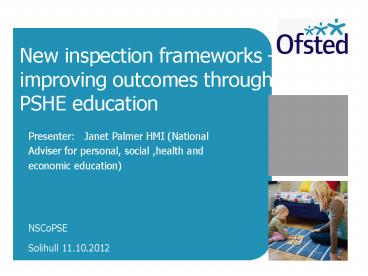New inspection frameworks - PowerPoint PPT Presentation
1 / 13
Title:
New inspection frameworks
Description:
New inspection frameworks improving outcomes through PSHE education Presenter: Janet Palmer HMI (National Adviser for personal, social ,health and economic education) – PowerPoint PPT presentation
Number of Views:158
Avg rating:3.0/5.0
Title: New inspection frameworks
1
New inspection frameworks improving outcomes
through PSHE education
- Presenter Janet Palmer HMI (National Adviser
for personal, social ,health and economic
education)
NSCoPSE Solihull 11.10.2012 02 October 2012
2
New Frameworks for Inspection
- Section 5 inspection of Maintained Schools and
Academies - 4 main judgments achievement of pupils
- quality of
teaching - behaviour and
safety of pupils - quality of
leadership and management
3
Overall effectiveness
- This takes account of the four main judgements
and how the school promotes the pupils
spiritual, moral, social and cultural (SMSC)
development.
4
Where SMSC is good
- pupils are reflective about beliefs, values and
more profound aspects of human experience, using
their imagination and creativity, and developing
curiosity in their learning - pupils are able to develop and apply an
understanding of right and wrong in their school
life and life outside school - pupils take part in a range of activities
requiring social skills - Pupils develop awareness of and respect for
diversity in relation to, for example, gender,
race, religion and belief, culture, sexual
orientation and disability
5
Where SMSC is good .
- pupils gain a well-informed understanding of the
options and challenges facing them as they move
through the school and on to the next stage of
their education or training - pupils develop an appreciation of theatre, music
art and literature and they respond positively to
a range of artistic, sporting and other cultural
opportunities - pupils develop the skills and attitudes that
enable them to participate fully and positively
in democratic modern Britain - Pupils understand and appreciate the range of
different cultures within school and further
afield as an essential element of their
preparation for life.
6
Factors common to schools with outstanding PSHE
- No preferred delivery model but all have in
common - Pupils with excellent personal and social skills
able to articulate their learning with maturity
independent learners taking responsibility - Teachers with excellent subject knowledge
skilful in teaching sensitive and controversial
topics use questioning to challenge and deepen
thinking assess learning rigorously - Curricular that meets individual and local needs
informed by local data bespoke for SEN/D uses
externals effectively monitors take up of
extra-curricular options - Leaders who champion PSHE high profile rigorous
ME that informs self-evaluation and improvement
planning governor support
7
Section 5 inspecting behaviour and safety
- There is an emphasis on behaviour, particularly
bullying much less on safety. - Inspectors must take into consideration
- Types, rates and patterns of bullying (including
actions to prevent and tackle discriminatory and
derogatory language) - The views of all stakeholders
- Pupils understanding and response to risk
- Attitudes to learning
- Analysis of incidents, attendance and exclusions
8
Behaviour and safety of pupils
- In relation to bullying, inspectors will
evaluate - types, rates and patterns of bullying and the
effectiveness of the schools actions - To prevent and tackle all forms of bullying and
harassment this includes cyber- - bullying and prejudice-based bullying related to
special educational need, sexual - orientation, sex, race, religion and belief,
gender identity or disability - the effectiveness of the schools actions to
prevent and tackle discriminatory - and derogatory language this includes
homophobic and racist language, - and language that is derogatory to disabled
people
9
Inspectors are expected to .
- evaluate pupils attitudes to homophobia and
other forms of prejudice - specifically ask about the types of language they
hear around the school - explore staff training on tackling different
aspects of bullying - consider how pupils are taught about diversity in
subjects such as PSHE education and citizenship
10
Section 5 grade descriptors for outstanding
behaviour and safety
- Pupils are fully aware of different forms of
bullying, including cyber-bullying and
prejudiced-based bullying, and actively try to
prevent it from occurring. Bullying in all its
forms is rare and dealt with highly effectively - All groups of pupils feel safe at school and at
alternative provision placements all times. They
understand very clearly what constitutes unsafe
situations and are highly aware of how to keep
themselves and others safe, including in relation
to e-safety
11
Section 5 grade descriptors for inadequate
behaviour and safety
- A significant minority of pupils show a lack of
respect and intolerance for each other or staff
and a lack of self-discipline, resulting in poor
behaviour around the school. - Incidents of bullying overall or specific types
of bullying are frequent, and/or pupils have
little confidence in the schools ability to
address bullying successfully. - Pupils or particular groups of pupils do not feel
safe at school and/or at alternative placements
12
Some key findings from No Place for Bullying
survey
- Inspectors found that language that discriminated
against pupils who were gay or perceived to be
gay, was common. As one secondary school pupil
commented, Its kind of used to mean rubbish. - Few schools had a clear stance on the use of
homophobic or disablist language or the
boundaries between banter and behaviour that
makes people feel threatened or hurt. Staff did
not always feel confident to challenge or have
the strategies to do so. - This generally did not extend to racism (which
was almost universally seen as the worst insult
and as unacceptable) but always included gay
and lesbian.
13
Thank you































